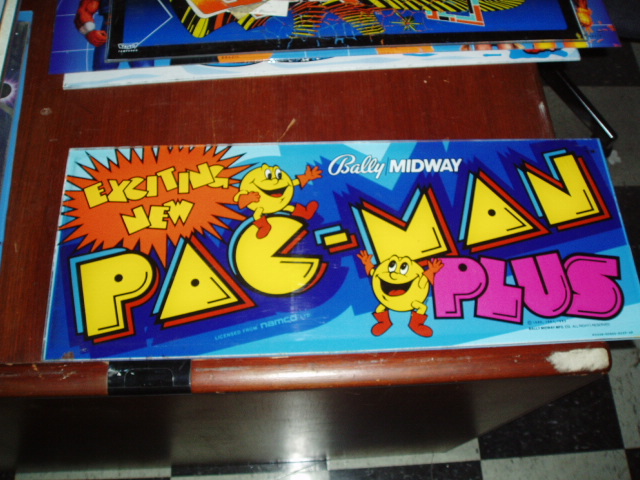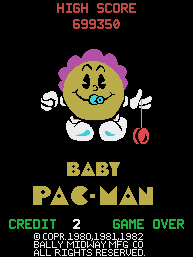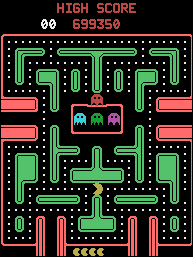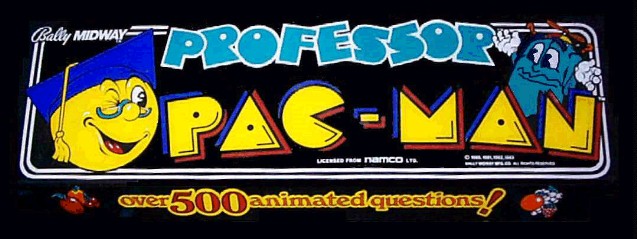NamCompendium Gaiden I: Pac-Man's Estranged Relatives
By jeffrud 7 Comments
The brilliant Ms. Pac-Man was the offspring of what amounted to stretching the terms of a licensing agreement between Namco and Midway. The latter wanted to leverage the former’s intellectual property for more arcade profits, and brought in General Computer Corporation’s bootleg expertise to create a game that sublimely iterates on an already incredible blueprint.
While the details remain murky, due in part to an agreement reached around 2007 between Ms. Pac-Man’s creators and Bandai Namco, it is evident that Namco in the early 1980s had an understanding with Midway (and to a lesser extent the developers they contracted) insofar as the rights to Ms. Pac-Man and the Pac-Man name were concerned. It is easy to imagine that Namco saw this as a straightforward licensing deal, with explicit approval given to Midway to handle distribution of Namco’s smash hit in North America. However, Midway clearly saw things differently. Ms. Pac-Man was not an aberration; in fact, Midway would develop and release four more arcade titles under the Pac-Man umbrella by the end of 1983.
Pac-Man Plus
13 March 1982 (ARC, North America)
The first of these four games might actually have warranted coverage in a full NamCompendium Prime article, as it has been “repatriated” by Bandai Namco over time and has been published by them on various platforms. It pairs better with the other games to be covered here, however, as it represents Midway’s continued interest in "utilizing" the Pac-Man brand. It also is something of an edge case as Pac-Man Plus was not a new game, per se, but rather a conversion kit for existing Pac-Man cabinets.

Pac-Man Plus was a few ROM chips and a Z80 with cabling, designed to seat into Namco’s Pac-Man boards to create a new game. This game is recognizably the same game cooked up by Iwatani Toru, but with changes designed to increase the amount of frankly random bullshit in the game. Specifically, the Power Pellets now trigger one of five game states: default Pac-Man blue ghosts, invisible blue ghosts, invisible walls, invisible walls and pellets, or a particularly shitty one where only three ghosts become vulnerable. The bonus item sprites have also been resequenced with a few more added in, including a shockingly bootlegged Coca Cola can. These bonus items, in addition to points, now trigger yet more weird hacky junk: now picking them up turns all of the ghosts invisible, but also triggers their “blue” state. It also doubles their points value, meaning capturing all four of them nets you a total of 6000 points versus the usual 3000.
As these things go, this is certainly not the earth shattering goodness of something like Ms. Pac-Man. It would have given arcade operators the ability to advertise a “new” game on the floor, and broken some proven strategies for high scores (and by extension, lengthy play sessions on a single quarter). I find the changes ultimately sully what is a nearly perfect game, and knowing it was all done just to extend the life of some arcade cabinets to make a buck doesn’t increase my love for it one iota.
But what was that about repatriation? It seems that Namco came to some sort of arrangement with Midway over Pac-Man plus. The game received a mobile port by Bandai Namco in the late 20-aughts, according to this archived website. Pac-Man Plus has also been included in at least one licensed Jakks Pacific TV Game unit, alongside the stellar Galaxian and the dirt worst Rally-X. Why Namco personnel would choose to highlight this kinda dodgy hack thing over, say, Ms. Pac-Man, is one of the deep philosophical questions that only the NamCompendium could incite.
The game has also made it to vintage consoles over the years thanks to the homebrew community. Opcode Games’ Pac-Man Collection for the ColecoVision includes Pac-Man Plus as a bonus, and the AtariAge community has produced versions for the 2600, 5200, and 7800.
Baby Pac-Man
11 October 1982 (ARC, North America)
Despite handshake agreements that took place to cover Ms. Pac-Man and Pac-Man Plus, Midway continued to abuse the goodwill of Namco with three more releases. The first of this fully unsanctioned trio is an absolute freak of nature. Baby Pac-Man is a combination arcade cabinet and pinball unit, with gameplay alternating between Pac-Man adjacent gameplay on a CRT and a miniaturized pinball table beneath it. The relationship between the two is the main “attraction” of this machine, and also the reason I found it to be chocked full of anti-fun.

I once heard it said that one of the reasons the International Space Station exists at all was to justify the continued existence of the American space shuttle program, by giving the shuttles someplace to go. I bring this up because Baby Pac-Man uses the pinball component of the game to make the Pac-Man component actively worse. You begin as a Baby Pac-Man in a maze with no power pellets and two tunnels leading out of the bottom of the screen. The only way to obtain power pellets or bonus items (or increase your somnambulatory speed in the maze) is drop down these tunnels, which begins a game of pinball. A game of pinball that takes place on a table about a third the length of your usual silver bill and plunger affair, with drop targets and bumpers for you to take down before inevitably dropping a ball because playing on table this short feels like a crime. Depending on your performance, you just might have spawned a power pellet in the maze (which now has no downward exits, as they close upon your return to Pac-Man mode). Grab the pellet, eat ghosts, repeat until you lose your quarter.

I had the opportunity to play one of these things in the flesh a few weeks ago at Quarterworld in east Portland, Oregon. I did not find the experience pleasurable. In addition to featuring the ugliest arcade Pac-Man visuals so far, I found the marriage of maze gameplay and farty pinball to be tenuous at best, and never gained a firm grasp of how my pinball play influenced the game above. It wound up being a very fast 50 cents for each three lives. When you add in the increased maintenance costs of maintaining both a pinball table and arcade cabinet into one unit, it should not surprise you that Baby Pac-Man was about as much of a dud with arcade operators as it was with gamers.
Namco seems to have no love lost on this one either, as it has never been re-released in any form. Due to its dual game nature, emulating this one is also a bastard.
Professor Pac-Man
12 August 1983 (ARC, North America)
So, this little ass disaster, right?
Professor Pac-Man takes the Pac-Man license abuse to the absolute stratosphere by taking the likeness of Iwatani’s little pizza-shaped protagonist and reducing him to a means of measuring the passage of time. Rather than feature any sort of gameplay with the loosest of ties to the source material, here a round yellow man with a mortarboard cap plays matching games with you. Players are tasked with answering “trivia” questions, though the trivia is less of the pop culture knowledge variety and more of the “how many of i in picture j had trait k” variety. Provide the wrong answers to three questions and wham, game over. The game steadily increases in speed over time, providing less and less time to scan an increasing amount of similar, janky looking sprite art for minute differences. It’s the sort of thing that the cheapest and least didactically meritorious edutainment software continues to peddle to this day, but with a more or less pilfered third party license slapped onto it for extra stank.

This was apparently build on Bally Midway’s Astrocade arcade hardware, the same sort of hardware which was consolized in the 1970s and played host to a few earlyunlicensed ports of Namco games. Even crazier, this game switched between two discrete banks of 512 kilobytes of ROM (for reference, the original Pac-Man fit into 16 kilobytes). Even crazier than that, Bally Midway had enough faith in this thing that there were plans for versions of Professor Pac-Man targeted towards younger audiences and casinos in addition to the regular arcade and bar crowds.
Perhaps craziest of all, while Namco has never touched this game with a thousand foot poll and neither should you, they’ve actually gone on to feature a character who sure looks like Professor Pac-Man in their games. The Pac-Man World series features a recurring character, Professor Pac, whose only real distinguishing feature from this assy bootleg-ass unlicensed turd is the inclusion of a white moustache. How’s that for trivia? Hey, I made a joke!
Professor Pac-Man is terrible garbage, and only escapes the very bottom of my ranked NamCompendium list by not being an official part of Namco history.
Jr. Pac-Man
13 August 1983 (ARC, North America)
Those who have followed the progress of the NamCompendium will know that I am the record as a scrolling maze hater. Though scrolling mazes had been tastefully implemented in Tengen’s Ms. Pac-Man, I generally find them to be a hinderance to Pac-Man gameplay in their penchant for failing to display all ghosts on screen at a given time. As if to piss me off specifically, Bally Midway went ahead and released an unlicensed Pac-Man sequel into arcades that relies on a scrolling view of the play field.
Jr. Pac-Man, released as a standalone cabinet and also in upgrade kit form, doesn’t let you see part of the game you are playing. It’s actually not the worst implementation of this scrolling solution, honestly, and has more in common with Tengen’s implementation than Namco’s implementation used in the Game Boy ports of Pac-Man and Ms. Pac-Man. You have a full vertical view of the maze at all times, and the scroll reveals just over half of the maze at a given time. I don’t know which AI the ghosts here are keyed on, but they seem fairly tenacious and that generally serves to keep them on the same half of the maze as the player. The end result is a Pac-Man clone that manages to keep most fundamental parts of the base game in tact.

Huge mazes aside, there are other small changes here. There are no longer warp tunnels on the outer edges of the maze, meaning this game is all about evading ghosts via navigating the mazes themselves. Bonus items also receive a little tweak; here, bouncing across regular pellets change them into little hollow circles that net the player 50 points instead of the usual 10. As a risk-reward trade off, these pellets slow Jr. Pac-Man’s movement and thereby make the player more vulnerable to ghost murder. Also, allowing the bonus items to make contact with the power pellets will remove them from the field, forcing the player to make chase lest they lose out on the possible bonus points. These are nifty ideas, ones that I find more agreeable than the chicanery employed by Pac-Man Plus.
These little changes belie my main complaint with Jr. Pac-Man: the mazes are just too damn big. I don’t think having to spend at least twice as long trying to clear a single level improves the experience at all, and in fact detracts from it. It turns playing Pac-Man into more of a chore, and few things are more damning to leisure activities than making them feel like work.
This sense of extra work is exaggerated in the Atari 2600 conversion of this game. Yes, this unlicensed sequel to Namco’s most celebrated creation received a licensed console courtesy of Atari Corporation. Advertised as early as 1984, prior to the division of Atari Prime into two entities, it was finally released by Atari Corporation sometime in 1986. Here the mazes are modified to scroll vertically instead of horizontally, revealing something like a third of the play field a given time. It’s a lot for the 2600 to display and hold in memory at once, and there is persistent flicker on the ghost sprites throughout (though to its credit there are four of them here). In fairness, this is also the solution reached by the good folks at Tengen years later when they sought to bring the Ms. Pac-Man experience to the NES, but here the vertical scrolling obscures too much of the map at a given time.
There was also an unreleased Atari 5200 port, developed in house by Atari in the same time frame as the 2600 port. Unlike the former, this was never officially released. Also unlike the former, this port did what it could to stick with the original game’s horizontal scrolling design. The overall visual design is on par with the 5200 versions of Pac-Man and Ms. Pac-Man, only now the game is measurably less good. This one slipped through the cracks amidst the general failure of the 5200 and Atari’s mitosis.
But wait, there’s more! Just when you thought it was time to end this special Gaiden entry of the NamCompendium, another damn homebrew conversion appears. Jr. Pac-Man landed on the Atari 7800 in 2009, courtesy of Bob DeCrescenzo. Featuring more refined sprites, better sound, and recreations of the arcade attract mode and interstitial cutscenes, I suppose you could say this is the best version of Jr. Pac-Man released for home consoles.
It was around the time of Jr. Pac-Man’s arcade publication that Namco had enough of Midway’s bullshit and altered the terms of their licensing agreement with the company. Rightly so; Pac-Man is a fantastic game, and dragging his name through the mud with dreck like Professor Pac-Man could have killed the golden goose for all parties involved if left unabated. These four misfit games, plus Ms. Pac-Man, constitute a strange little pocket universe comprised of what was possible when companies shared licenses across language barriers and time zones almost forty years ago. Each of these is worth giving a shot if you spot them in an arcade (except for the abominably bad Professor Pac-Man) just for the novelty factor alone.
Welp, I’m really sick of talking about yellow, loosely anthropomorphic ball people. Maybe next time we’ll talk about some cars?
<- Take me back to the NamCompendium

7 Comments